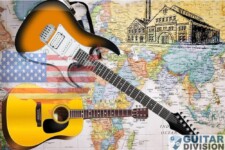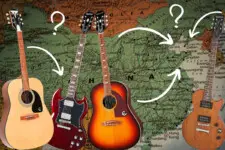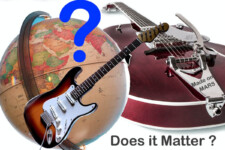Guitars Made in Indonesia vs China – Which Are Best?
For a long time, guitar lovers have argued which guitars are better than others, depending on their country of origin.
The comparison between Chinese and Indonesian-made guitars has always received plenty of attention in this debate.
Does it matter if a guitar was made in China or Indonesia?
China potentially has more advanced guitar production machinery than Indonesia. However, many agree that what matters most is the design, quality control, and the amount of detail placed into the guitar manufacturing process.

Let’s take a deeper look at the guitars, prices, manufacturing, and reputation of Indonesia and China as guitar-producing nations.
What Do Guitar Players Think?
After reading many debates on various forums and speaking with guitar owners, you’ll find that guitar players are equally divided on whether Indonesian guitars are better than Chinese guitars.
Many players argue that the price range is the key differentiator, stating that no matter whether a guitar is made in China or Indonesia – if they are in the same price range they are more or less the same.
For instance, a $185 Yamaha Pacifica made in Indonesia ranks similarly to a $225 Ibanez GSA–60 made in China.
Nevertheless, some players argued that Indonesia produced better guitars than China.
For example, Fender recently moved their Squier Classic Vibe manufacturing from China to Indonesia. Some Players claimed that the ones from Indonesia were better than those from China.
Also, given China’s otherwise negative reputation for producing cheap and fake products, many players chose the Indonesian guitars over the Chinese.
Some mid-range guitars like the Breedlove Discovery series currently made in China are proving more and more popular with guitar players. It seems likely that the longer they build guitars, the better their reputation will become.
It’s important to note that higher-end guitars (particularly acoustic) are not the focus of this conversation, as neither country has a reputation for producing truly artisan guitars.
How Long Have China & Indonesia Made Guitars?
In the 1950s, America, Japan, and Korea manufactured most guitars, but with the rise of worker demands for better pay in these countries, manufacturers had to look for cheaper areas to produce guitars.
Companies like PRS moved into China and Yamaha into Indonesia where production costs were significantly lower.
These two countries continued attracting guitar companies, which set up manufacturing plants as time went by.
China and Indonesia have now been making well-known guitar brands for over twenty years.
Consequently, you will find that many entry-level (acoustic and electric) guitar brands originate from either Indonesia or China.
Which Guitars are Made in Indonesia?
Yes, Indonesia is a leading guitar producer, so what are some of the guitar brands made in Indonesia? Let’s take a look.
Squier Classic Vibe Stratocaster – Largely used for getting that classic blues tone, the guitar has a vintage fender look and good playability.
Gretsch G2622 Streamliner – The G2622 has an extensive jazz player following since it has great deep tones, fitted with dual humbuckers and 3 individual volume controls.
Ibanez Premium S107OPBZ – Many guitar players love the Ibanez Premium due to its incredibly versatile pickup combinations and speed shredding.
ESP LTD EC-1000 – Guitar players consider the ESP LTD-1000 guitar the best used for metal. ESP guitars are high-quality guitars made initially in Japan, but then due to cost reasons the company set up shop in Indonesia.
Schecter Omen Extreme-6 – A highly affordable guitar with a stunning quill maple top and excellent tonal flexibility thanks to its maple cap.
Others include
- Yamaha Pacifica PAC612VIIFM
- Squier Classic Vibe Telecaster
- Sterling by Music Man Majesty
PRS SE Series guitars are made at the PT Cort factory in Indonesia, check out their processes here:
Which Guitars are Made in China?
China has a collection of high-quality guitar brands. Let us look at some of these guitars.
Epiphone ES-335 – Sharing numerous characteristics with the American Gibson ES-335, this guitar has a hollow body, produces a classical sound, and vintage style.
Squier Affinity Telecaster – If you are a country music lover looking to achieve a Nashville twang, then you will love this guitar with its stimulating Telecaster tone.
Jackson Dinky Arch Top JS22 – from the Jackson Dinky looks alone, you already know the guitar means business. The Jackson Dicky has a tremolo bar and graphite-reinforced neck, making it perfect for metal.
Yamaha FG800 – When looking for a budget-friendly acoustic guitar, you will be more than happy to pick the Yamaha FG800 which gives you great value for money.
Eastman SB59 – many guitar lovers compare this to the Gibson model due to its deep clear sound and easy handling. Though the Eastman SB59 is not a famous brand, you will be surprised by how well it delivers tone and playability.
Squier Affinity Stratocaster – Highly regarded by many players as the best beginner-friendly guitar. This Strat is easy to handle with a specially designed neck for comfort, and includes three single-coil pickups that enable tone versatility.
Other brands include
- Epiphone Tony Iommi SG Custom.
- Ibanez GRGR120EX
- Epiphone Les Paul Standard 60’s
How Much do Chinese Vs Indonesian Guitars Cost?
To fully answer the above question, we need to compare the prices of guitars from China and Indonesia at different levels.
Entry-Level Acoustic Guitars
| Acoustic Guitar | Country of Origin | Price |
| Mitchell D120 | China | $150 |
| Fender FA-125 | Indonesia | $170 |
| Epiphone PR-150 | China | $200 |
| Ibanez PF18WDB | Indonesia | $180 |
Entry-Level Electric Guitars
| Electric Guitar | Country of Origin | Price |
| Ibanez GIO series | China | $200 |
| Yamaha PAC012DLX Pacifica | Indonesia | $210 |
| Epiphone LP Special I | China | $180 – 250 |
| Squier Bullet Stratocaster | Indonesia | $200 |
Lower Midrange Acoustic Guitars
| Acoustic Guitar | Country of Origin | Price |
| Mitchelle T311CE | Indonesia | $330 |
| Walden Standard | China | $280 |
| Schecter Deluxe | China | $300 |
| Silverstone 955CE | Indonesia | $400 |
Lower Midrange Electric Guitars
| Electric Guitar | Country of Origin | Price |
| Ibanez ART120QA | China | $350 |
| Gretsch G2622 Streamliner | Indonesia | $450 |
| Schecter Omen | China | $450 |
| Squier Classic Vibe | Indonesia | $450 |
Mid-Range Acoustic Guitars
| Acoustic Guitar | Country of Origin | Price |
| Fender PM3 Standard | Indonesia | $630 |
| Guild OM 12O Westerly | China | $670 |
Mid-Range Electric Guitars
| Acoustic Guitar | Country of Origin | Price |
| Schecter Damien | Indonesia | $600 |
| Epiphone ES-335 | China | $600 |
After looking at the three tables above, you will notice that Chinese guitars and Indonesian guitars generally have similar prices.
Except for the lower midrange level acoustic guitars, Indonesian guitars cost more than Chinese guitars.
Which Guitar Factories are in Indonesia?
Indonesia has slowly grown to become one of the largest guitar manufacturers in the world, producing both acoustic and electric guitars.
You will find that two come from Indonesia out of every six guitars sold in a music or guitar shop.
The country’s supportive laws and not so costly labor have attracted manufacturers significantly.
Some of the guitars Factories in Indonesia include:
- Yamaha music manufacturing Indonesia PT
- Cort Indonesia
- PT. Samic Indonesia
- PT.Woosnam Music
- PT. World Music Industries
- PT. Bahari Eka Nusantara
- PT.Samic Indonesia
- PRS industries Indonesia
- Ambur Wolan Co. LTD
Which Guitar Factories are in China?
Being the highest industrialized country in the world; China has its fair share of Guitar producing factories.
These companies include:
- Tianjin H&W instrument Company limited
- Yangzhou Lingdong musical Instruments Company limited
- Shenzen Grand technology Company Limited
- Artland Company Music Limited
- Pango Music (Shangdong) company limited
- Aileen Music Company Limited
- Taixing Lucky Musical Instruments Company Limited
- Qingdao Evergreen Maritime Company Limited
How Much Experience do Indonesian Luthiers Have?
Since Indonesia has a moderately priced labor force you may think they are not skilled, but you would be mistaken!
Many of the guitar manufacturers in Indonesia produce guitars for major American brands. Therefore, many of these companies only employ highly skilled luthiers to work in their factories.
Let’s take Paul Reed Smith Guitars (PRS), a Student Edition factory in Indonesia as an example.
The company’s chief operating officer has more than twenty years of experience, and the company only hires luthiers with at least three years of experience then takes them through a rigorous training period.
In 2008, Peter Macken conducted a study comparing the levels of knowledge of workers in Indonesia in various industries. He found that the guitar industry had the second-highest experienced workers in his analysis.
Guitar luthiers in Indonesia generally have between five to twenty years of experience.
In addition, considering that the guitar-making process is highly taxing, luthiers work on shifts to ensure quality.
How Much Experience Do Chinese Luthiers Have?
China has a reputation for producing low-quality guitars, however this perception is slowly changing as more manufacturers have their guitars made there, and Chinese luthiers gain more years of experience.
Chinese guitar makers primarily employ skilled workers and then train them to enhance their skills. After the training, the employees can start working in the plants.
On average, a Chinese guitar factory worker has between five to fifteen years of experience.
This may seem relatively low, but the factories are highly mechanized. Thus, the human touch on the guitars is lower – one reason some players consider Chinese guitars inferior.
Does it Matter Where Guitars Are Made? – Find out more in this post.
What Machinery Does Indonesian Guitar Factories Use?
In earlier days, guitar production was largely handmade, but this has changed with the onset of technology. Machines enhance production, ensure uniformity, reducing the number of staff needed.
Most guitars-making companies in Indonesia are highly mechanized, but some only make handmade guitars.
The mechanized companies use machines like:
- Driers – to completely dry and cure the wood.
- Computerized CNC machines – to cut the wood into exact shapes.
- Automated Pressers – to accurately press guitars into required shapes.
Remember we stated that some manufacturers have stuck with making handmade guitars? Well, that does not mean that they don’t use any machines.
They use machines for some of their procedures, but their employees personally work on each guitar for the most part.
What Machinery is Used by Chinese Guitar Factories?
To keep up with their highly industrialized reputation, Guitar factories in China use numerous machines in their guitar production.
They use computer numerical control machines such as Plek, which even top American companies use, plus a host of other appliances like winding machines and engraving routers.
Chinese guitar makers use higher levels of machinery than Indonesia, and could possibly suffer a little due to less of the ‘personal-touch’ that often defines the subtle characteristics of a guitar.
Who Is the Winner?
The choice can come down to the brand, the price of the guitar, or even if it’s an electric or acoustic guitar. Some brands have demanded higher quality control regardless of the country they locate their factory in and accordingly, put more money into the manufacturing process.
For instance, Epiphone when setting up their Chinese factory used Korean staff with many years of experience to bring their knowledge to local workers.
After a few years, the local workers were producing guitars that would rival any other country for quality.
As with both Indonesia and China, when factories first started making guitars there the quality was dubious at best, but after two decades both countries are now producing entry to mid-level guitars of similar quality.
Thus, though many players prefer Indonesian guitars to the Chinese, there is no clear winner between the two.



